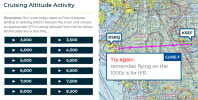You are using an out of date browser. It may not display this or other websites correctly.
You should upgrade or use an alternative browser.
You should upgrade or use an alternative browser.
AOPA Rusty Pilots course
- Thread starter roncachamp
- Start date
Oops. Looks like that one slipped through the editing process.what are your thoughts on the course response?
roncachamp
Final Approach
The odd cardinal + 500 feet answers all got a Great Job! response, the others all drew a Try Again.Oops. Looks like that one slipped through the editing process.
luvflyin
Touchdown! Greaser!
Yeah, yeah, 3000 is ok because it’s below 3000 AGL. Have you written them and called them out on this flagrant error of theirs.This is a screenshot from Chapter 2, Preflight & Preparation. I selected 3,000 feet, what are your thoughts on the course response?
roncachamp
Final Approach
Not yet. The error is repeated in the end of chapter quiz.Yeah, yeah, 3000 is ok because it’s below 3000 AGL. Have you written them and called them out on this flagrant error of theirs.
Pinecone
En-Route
Yeah, yeah, 3000 is ok because it’s below 3000 AGL. Have you written them and called them out on this flagrant error of theirs.
WEELLLLL, it is Florida. So in some places 3000 MSL maybe greater than 3000 AGL.
Clip4
Final Approach
It’s an AOPA rusty pilot course. Why would you fly your business jet at 3500 feet? The answer is a high as you can.
roncachamp
Final Approach
Yeah, yeah, 3000 is ok because it’s below 3000 AGL. Have you written them and called them out on this flagrant error of theirs.
Had a rather interesting exchange with AOPA Pilot Information Center on this.
Me: "This is a screenshot from Chapter 2, Preflight & Preparation. I selected 3,000 feet, that was deemed to be an incorrect answer. 3,000 MSL is an appropriate altitude for VFR operations because it is below 3,000 AGL, the altitude where the hemispheric rule begins."
AOPA: "VFR altitudes start in altitudes ABOVE 3000', so in this case eastbound would be odds plus 500 which should yield a 3500' cruising altitude."
Me: "An MSL altitude is an altitude expressed in feet measured from mean sea level. An AGL altitude is an altitude expressed in feet measured above ground level. The hemispheric rule for VFR cruising altitudes begins above 3000 feet AGL. A flight from KSRQ to KSEF flown at 3000 feet MSL is entirely below 3000 feet AGL, making 3,000 a correct response to this question."
AOPA: "You are correct. We should not have listed 3000’ as a choice. The course developer has this on her list to correct along with the quiz question at the end of the chapter.
"Thanks for pointing this out. I hope you enjoyed the course regardless."
Randomskylane
Line Up and Wait
- Joined
- Jun 2, 2021
- Messages
- 663
- Display Name
Display name:
Randomskylane
Now do it on the 1,300 questions on the written ir test!
roncachamp
Final Approach
I don't believe I'm familiar with those questions.Now do it on the 1,300 questions on the written ir test!
luvflyin
Touchdown! Greaser!
You should get like a finders fee or sumpin'Had a rather interesting exchange with AOPA Pilot Information Center on this.
Me: "This is a screenshot from Chapter 2, Preflight & Preparation. I selected 3,000 feet, that was deemed to be an incorrect answer. 3,000 MSL is an appropriate altitude for VFR operations because it is below 3,000 AGL, the altitude where the hemispheric rule begins."
AOPA: "VFR altitudes start in altitudes ABOVE 3000', so in this case eastbound would be odds plus 500 which should yield a 3500' cruising altitude."
Me: "An MSL altitude is an altitude expressed in feet measured from mean sea level. An AGL altitude is an altitude expressed in feet measured above ground level. The hemispheric rule for VFR cruising altitudes begins above 3000 feet AGL. A flight from KSRQ to KSEF flown at 3000 feet MSL is entirely below 3000 feet AGL, making 3,000 a correct response to this question."
AOPA: "You are correct. We should not have listed 3000’ as a choice. The course developer has this on her list to correct along with the quiz question at the end of the chapter.
"Thanks for pointing this out. I hope you enjoyed the course regardless."
Randomskylane
Line Up and Wait
- Joined
- Jun 2, 2021
- Messages
- 663
- Display Name
Display name:
Randomskylane
The instrument test has some doozies, which is good for business for some test prep people (they actually tell you which questions require an obviously wrong answer) but a major pain for the people taking the testI don't believe I'm familiar with those questions.
roncachamp
Final Approach
It's been over forty years since I took that test. I'm confident the test I took was very different from the tests today.The instrument test has some doozies, which is good for business for some test prep people (they actually tell you which questions require an obviously wrong answer) but a major pain for the people taking the test
Brad Z
Final Approach
When did you take the test? Do you recall the questions that are wrong?The instrument test has some doozies, which is good for business for some test prep people (they actually tell you which questions require an obviously wrong answer) but a major pain for the people taking the test

